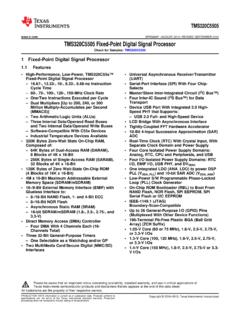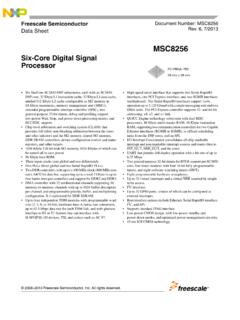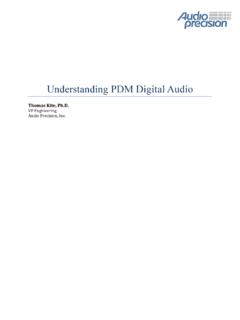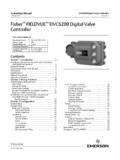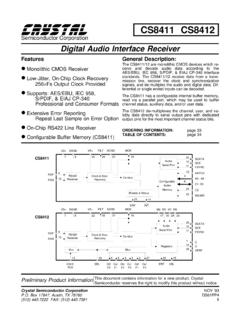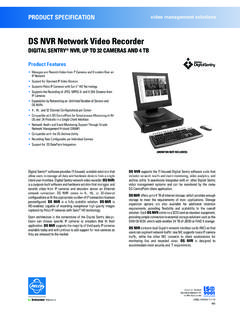Transcription of APR8 - Principles of Sigma-Delta Modulation for Analog-to ...
1 Motorola digital signal Processors Principles of Sigma-Delta Modulation for Analog-to - digital Converters by Sangil Park, Ph. D. Strategic Applications digital signal processor Operation MOTOROLA APR8. Motorola reserves the right to make changes without further notice to any products here- in. Motorola makes no warranty, representation or guarantee regarding the suitability of its products for any particular purpose, nor does Motorola assume any liability arising out of the application or use of any product or circuit, and specifically disclaims any and all liability, including without limitation consequential or incidental damages. Typical pa- rameters can and do vary in different applications. All operating parameters, including Typicals must be validated for each customer application by customer's technical ex- perts.
2 Motorola does not convey any license under its patent rights nor the rights of oth- ers. Motorola products are not designed, intended, or authorized for use as components in systems intended for surgical implant into the body, or other applications intended to support or sustain life, or for any other application in which the failure of the Motorola product could create a situation where personal injury or death may occur. Should Buyer purchase or use Motorola products for any such unintended or unauthorized application, Buyer shall indemnify and hold Motorola and its officers, employees, subsidiaries, affili- ates, and distributors harmless against all claims, costs, damages, and expenses, and reasonable attorney fees arising out of, directly or indirectly, any claim of personal injury or death associated with such unintended or unauthorized use, even if such claim alleges that Motorola was negligent regarding the design or manufacture of the part.
3 Motorola and are registered trademarks of Motorola, Inc. Motorola, Inc. is an Equal Opportuni- ty/Affirmative Action Employer. Table of Contents SECTION 1 Introduction 1-1. SECTION 2 Conventional Analog-to - digital Converters 2-1. SECTION 3 Quantization Error in A/D Conversion 3-1. SECTION 4 Oversampling and Decimation Basics 4-1. SECTION 5 Delta Modulation 5-1. SECTION 6 Sigma-Delta Modulation for A/D Converters 6-1. (Noise Shaping). Analysis of Sigma-Delta Modulation in 6-6. Z-Transform Domain SECTION 7 digital Decimation Filtering 7-1. Comb-Filter Design as a Decimator 7-5. Second Section Decimation FIR Filter 7-10. SECTION 8 Mode Resolution by Filtering the Comb-Filter 8-1. Out put with Half-Band Filters SECTION 9 Summary 9-1. REFERENCES References-1.
4 MOTOROLA iii Illustrations Figure 2-1 Generalized Analog-to - digital Conversion Process 2-2. Figure 2-2 Conventional Analog-to - digital Conversion Process 2-3. Figure 2-3 Spectra of Analog and Sampled Signals 2-5. Figure 3-1 Quantization Error 3-3. Figure 3-2 Noise Spectrum of Nyquist Samplers 3-3. Figure 4-1 Comparison Between Nyquist Samplers and 2X. Oversamplers 4-3. Figure 4-2 Anti-Aliasing Filter Response and Noise Spectrum of Oversampling A/D Converters 4-5. Figure 4-3 Frequency Response of Analog Anti-Aliasing Filters 4-6. Figure 4-4 Simple Example of Decimation Process 4-7. Figure 5-1 Delta Modulation and Demodulation 5-2. Figure 6-1 Derivation of Sigma-Delta Modulation from Delta Modulation 6-1. Figure 6-2 Block Diagram of Sigma-Delta Modulation 6-2.
5 Figure 6-3 S-Domain Analysis of Sigma-Delta Modulator 6-3. Figure 6-4 Block Diagram of First-Order Sigma-Delta A/D. Converter 6-5. Figure 6-5 Input and Output of a First-Order Sigma-Delta Modulator 6-6. Figure 6-6 Z-Domain Analysis of First-Order Noise Shaper 6-7. Figure 6-7 Spectrum of a First-Order Sigma-Delta Noise Shaper 6-9. MOTOROLA v Illustrations Figure 6-8 Second-Order and Third-Order Sigma-Delta 6-10. Noise Shapers Figure 6-9 Multi-Order Sigma-Delta Noise Shapers 6-13. Figure 6-10 Spectra of Three Sigma-Delta Noise Shapers 6-13. Figure 7-1 digital Decimation Process 7-4. Figure 7-2 Block Diagram of One-Stage Comb Filtering Process 7-6. Figure 7-3 Transfer Function of a Comb-Filter 7-7. Figure 7-4 Cascaded Structure of a Comb-Filter 7-8.
6 Figure 7-5 Aliased Noise in Comb-Filter Output 7-9. Figure 7-6 (a) Comb-Filter Magnitude Response in Baseband 7-11. (b) Compensation FIR Filter Magnitude Response 7-11. Figure 7-7 FIR Filter Magnitude Response 7-12. Figure 7-8 Aliased Noise Bands of FIR Filter Output 7-13. Figure 8-1 Spectrum of a Third-Order Noise Shaper (16384 FFT bins) 8-2. Figure 8-2 Spectrum of Typical Comb-Filter Output (4096 FFT bins) 8-3. Figure 8-3 Decimation Process using a Series of Half Band Filters 8-5. vi MOTOROLA. Tables Table 8-1 Parameters for Designing Half-Band Filters 8-4. MOTOROLA vii SECTION 1. Introduction Since the The performance of digital signal processing and A/D converters communication systems is generally limited by the are based on precision of the digital input signal which is achieved digital filtering at the interface between analog and digital informa- techniques, tion.
7 Sigma-Delta ( ) Modulation based Analog-to - almost 90% of digital (A/D) conversion technology is a cost effective the die is alternative for high resolution (greater than 12 bits). implemented in converters which can be ultimately integrated on dig- digital circuitry ital signal processor ICs. which enhances the prospect of compatibility. Although the Sigma-Delta modulator was first intro- duced in 1962 [1], it did not gain importance until recent developments in digital VLSI technologies which provide the practical means to implement the large digital signal processing circuitry. The increas- ing use of digital techniques in communication and audio application has also contributed to the recent in- terest in cost effective high precision A/D converters.
8 A requirement of Analog-to - digital (A/D) interfaces is compatibility with VLSI technology, in order to provide for monolithic integration of both the analog and digi- tal sections on a single die. Since the A/D. converters are based on digital filtering techniques, almost 90% of the die is implemented in digital circuit- ry which enhances the prospect of compatibility. MOTOROLA 1-1. Additional advantages of such an approach in- clude higher reliability, increased functionality, and reduced chip cost. Those characteristics are com- monly required in the digital signal processing environment of today. Consequently, the develop- ment of digital signal processing technology in general has been an important force in the devel- opment of high precision A/D converters which can be integrated on the same die as the digital signal processor itself.
9 The objective of this application report is to explain the technology which is im- plemented in the DSP56 ADC16, and show the superior performance of the converter compared to the performance of more conventional imple- mentations. Particularly, this application note discusses a third-order, noise-shaping oversam- pling structure. Conventional high-resolution A/D converters, such as successive approximation and flash type con- verters, operating at the Nyquist rate (sampling frequency approximately equal to twice the maxi- mum frequency in the input signal ), often do not make use of exceptionally high speeds achieved with a scaled VLSI technology. These Nyquist sam- plers require a complicated analog lowpass filter (often called an anti-aliasing filter) to limit the maxi- mum frequency input to the A/D, and sample-and- hold circuitry.
10 On the other hand, A/D convert- ers use a low resolution A/D converter (1-bit quantizer), noise shaping, and a very high oversam- pling rate (64 times for the DSP56 ADC16). The high resolution can be achieved by the decimation (sam- ple-rate reduction) process. Moreover, since 1-2 MOTOROLA. precise component matching or laser trimming is not needed for the high-resolution A/D convert- ers, they are very attractive for the implementation of complex monolithic systems that must incorpo- rate both digital and analog functions. These features are somewhat opposite from the require- ments of conventional converter architectures, which generally require a number of high precision devices. This application note describes the con- cepts of noise shaping, oversampling, and decimation in some detail.
